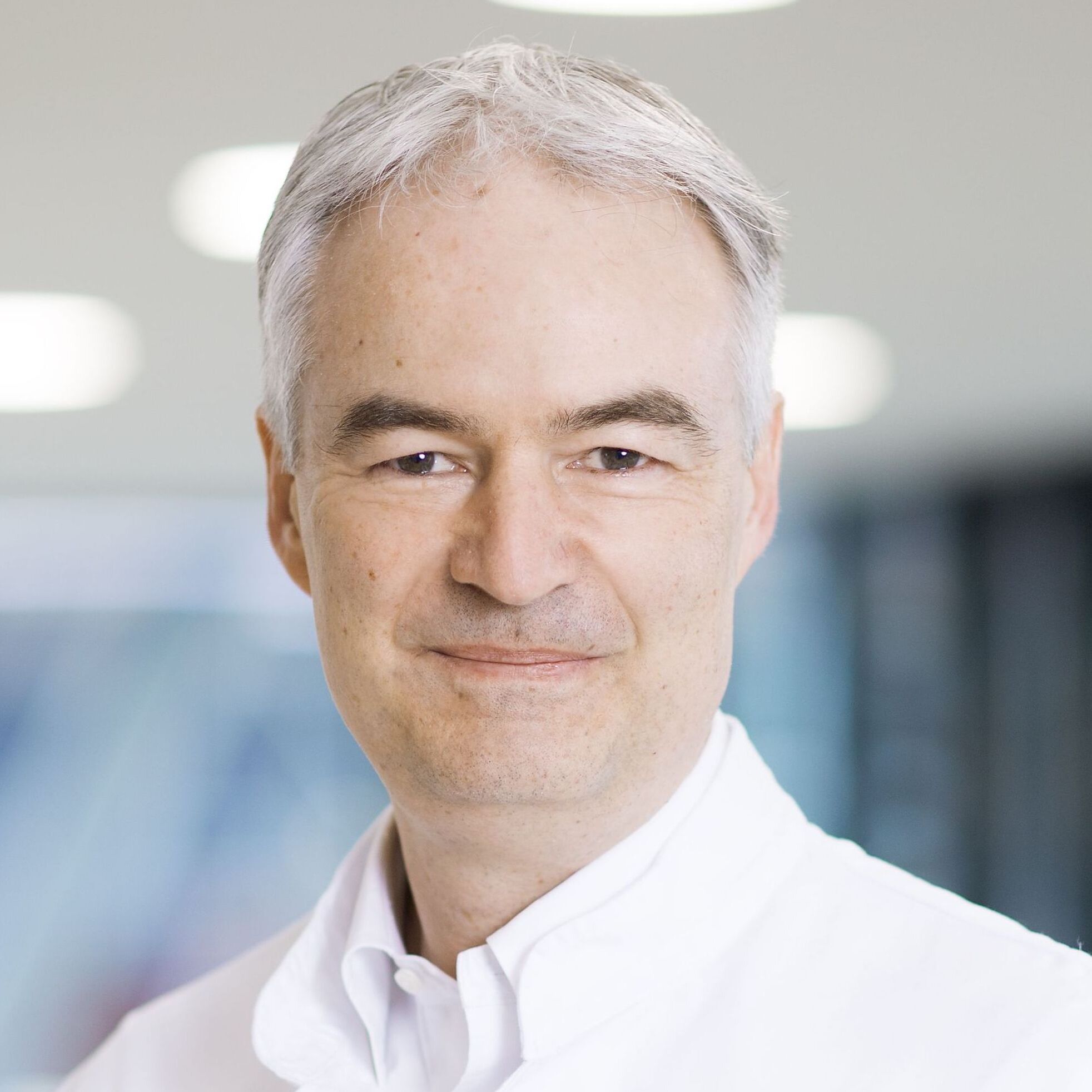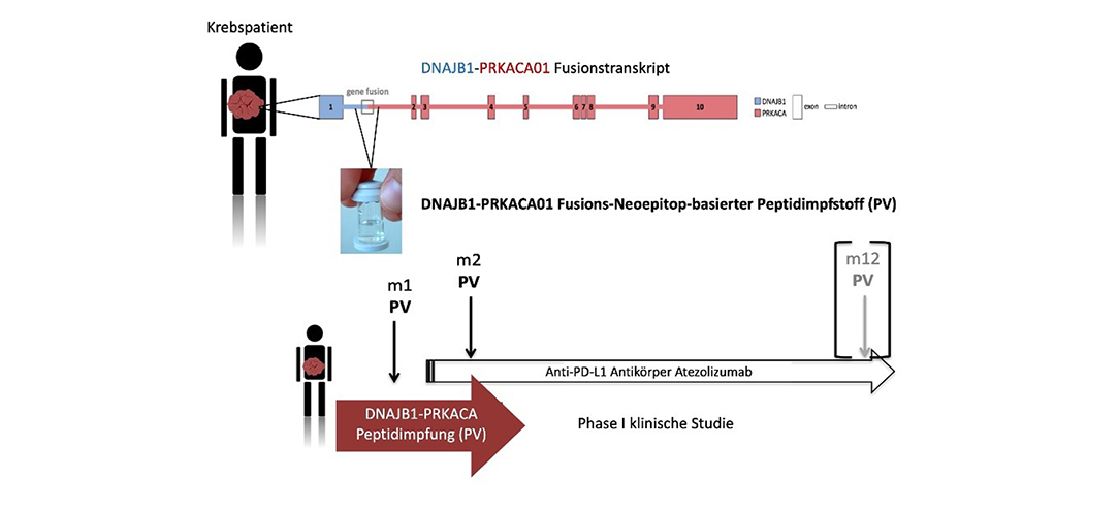For advanced fibrolamellar hepatocellular carcinoma (FL-HCC), there is no standard systemic therapy (i.e. effective on tumor cells throughout the entire body). Medical treatment options are also limited for other tumor diseases with evidence of the DNAJB1-PRKACA gene fusion, such as certain malignant neoplasms of the pancreas or bile ducts. This study evaluates the therapeutic cancer peptide vaccine Fusion-VAC-XS15 in combination with immune checkpoint blockade by atezolizumab (Tecentriq®) as a therapy for advanced fibrolamellar hepatocellular carcinoma or other tumor diseases with evidence of the DNAJB1-PRKACA gene fusion.
Combined immunotherapy:
Peptide vaccination plus immune checkpoint blockade for tumors with DNAJB1-PRKACA gene fusions
Overview
Why is there no standard systemic therapy for FL-HCC?
FL-HCC is a rare tumor disease that typically affects people without a history of underlying liver disease. In recent years, an increasing incidence of these tumors has been observed. To date, the 5-year survival of patients with FL-HCC is only 45%. This is mainly due to the fact that removal of the tumor by surgery is so far the only treatment option that can achieve a cure. However, surgery can only be performed meaningfully if the cancer is diagnosed before metastases (spread of tumor cells to other organs) occur. If such metastases have already appeared or if the disease has relapsed in the form of metastases after primary surgery, the only option is a so-called systemic therapy that reaches all tumor cells in the body, for example using chemotherapy. However, according to current knowledge, FL-HCC rarely responds to chemotherapies or other systemic therapies in the long term, so there is currently no standard treatment for advanced FL-HCC. This makes the development of new treatment options urgently necessary.
What is a therapeutic cancer vaccine?
For many years, vaccinations have been used to prevent contagious diseases such as measles, mumps and influenza. The principle of these vaccinations is that parts of pathogens (also called antigens) are administered to patients. This activates and alerts the immune system to these pathogens so that in the event of a subsequent encounter they are recognized and fought by the body’s own defensive systems. Today, it is believed that a new type of vaccination can also be used to treat tumors. In contrast to infectious diseases, which can be prevented by vaccination, these cancer or tumor vaccines are used for those patients who have already developed cancer, so they are referred to as therapeutic cancer vaccines. An attractive target for such a therapeutic cancer vaccination in advanced tumor diseases is a specific genetic recognition feature of the tumor. This alteration can be used as a target structure to direct the immune system against the tumor with a therapeutic cancer vaccination.
What is a fusion transcript?
In recent studies of tumor tissue from patients with fibrolamellar hepatocellular carcinoma, the so-called DNAJB1-PRKACA gene fusion was identified as a genetic hallmark of the tumor. A fusion transcript is a "combined" protein that is formed based on the fusion of two different genes and is significantly responsible for tumor emergence. The DNAJB1-PRKACA gene fusion is present in FL-HCC as a trigger of tumor formation, but there are also individual cases of other tumor diseases, e.g. of the pancreas or bile ducts, in which the DNAJB1-PRKACA fusion transcript is detected.
The Fusion-VAC-XS15 vaccine
The therapeutic cancer vaccine Fusion-VAC-XS15 administered in this study contains a peptide (protein) derived from this DNAJB1-PRKACA gene fusion. In order for the therapeutic cancer vaccine to induce an immune system response against the tumor, an immune stimulator called an adjuvant must be used in addition to the vaccine peptide. The adjuvant used in this study is the substance XS15, which is injected under the skin together with the vaccine peptide and the emulsifier Montanide. XS15 serves to activate the immune cells at the vaccination site, thus enabling a strong response from the immune system. Results on the use of XS15 in humans from initial studies are promising with respect to the tolerability and efficacy of this immune stimulator. Preliminary results from several ongoing studies with peptide vaccines containing XS15 show that a good and strong response of the immune system against the respective vaccine peptides can be stimulated by the vaccination, especially regarding the so-called T-cells, a vital part of the body’s own immune defenses.
What is immune checkpoint inhibitor therapy?
A checkpoint inhibitor is an antibody that activates particular immune cells (called T cells) by blocking the interaction of the PD1 receptor (PD1 = programmed cell death protein 1), a marker site on immune cells, with the PD1 ligand (PD-L1 =programmed cell death 1 ligand 1), which is why they are also called checkpoint blockers. Some tumors produce the protein PD-L1 that, by binding to the PD1 receptor, prevents the body's immune cells from recognizing and effectively fighting the tumor. By blocking the PD-1 receptor or PD-L1, immune cells are once again enabled to do their work, as the cancer is now more visible to the immune system and can be better fought by the patient's own body. However, the effect of a checkpoint inhibitor is general and non-specific, i.e. not targeted against a specific type of tumor. In this particular case, the specific response of the immune system against the tumor triggered by therapeutic vaccination should be enhanced and improved by the checkpoint inhibitor. The checkpoint inhibitor used in this study, atezolizumab (Tecentriq®), an antibody directed against PD-L1, is provided by Roche Pharma AG.
Aim of the study
Patients wanted!
Who can participate in the study?
- Patients who are 18 years or older,
- with locally advanced or metastatic FL-HCC
- or with other malignant, locally advanced or metastatic tumor disease with evidence of the DNAJB1-PRKACA fusion transcript for which no established standard therapy is available.
Interested in participating in a study?
If so, please contact the KKE Translational Immunology by e-mail.
E-mail address: kketi@med.uni-tuebingen.de
How does the study work?
Preselection
The purpose of the preselection phase is to determine if you can participate in this study. This pretesting usually takes about 3-4 hours. Only when the results of all tests are available, will your investigator be able to tell you whether you are eligible for the study or not.
Vaccinations
You will receive at least two vaccinations with the Fusion VAC XS15 peptide vaccine as part of the study. The vaccinations are given subcutaneously, which means that the vaccine is injected under the skin of your abdomen with a needle. To study the effect of the vaccine on your immune system, blood samples will be taken periodically. There is a possibility of revaccination after 11 months, if your immune response to the initial two vaccinations has already measurably decreased by that time.
Therapy
You will receive atezolizumab as an intravenous infusion every four weeks. Treatment will be given for twelve months unless there is disease progression or other reasons to discontinue the study.
Follow-up
After the last atezolizumab infusion, it is necessary for you to come to the hospital four times for four follow-ups. The last check-up and end of the study is six months after the last treatment.
Principal investigator

Prof. Dr. Juliane Walz
Medical Director KKE Translational Immunology, Department of Medicine
University Hospital Tübingen
Scientific management of the study / Sponsors Delegate
Person profile: More about the person

Prof. Dr. Helmut Salih
Medical Director KKE Translational Immunology, Medical Clinic University Hospital Tübingen
Principal Investigator of the study
Person profile: More about the person
See also

Deputy Medical Director Internal Medicine I; Deputy principal Investigator of the study
Publications: Publications

